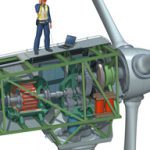Wind farm management, especially offshore, is a matter of economy: generate greater amounts of energy per area, and reduce the cost per megawatt. However, as the industry continues to evolve to meet enhanced power production, it also means increased challenges and risks for project managers—unknowns that push the boundaries of being able to control the transportation and logistics process and its resulting costs. Pushing the boundaries also means pushing the limits of your logistics providers. Every reduction in the cost per MW goes right to the bottom line.
Each offshore wind power project is different. The challenges vary, including moving the all-important support structures from origin to site. Steel tube monopiles are the most common, while the larger footprint multi-pile and tripods, jackets, and steel or concrete gravity base structures are also being used on a number of projects, especially as wind turbines get larger and are being located in deeper water.
Supply Chain Management
As wind farm development becomes more complex, it is important to ensure that your supply chain resources are the best. Take the transport of monopiles from production sites in, say, Germany or South Korea to the United States. On a full charter basis, the costs can be significant. An experienced logistics provider can bring transportation solutions that can reduce the costs.
The Cape Cod wind farm project in the U.S. will need 130 monopiles, for instance, which requires a large number of shiploads as well as unloading and transporting to the sites. The delivery of so much heavy wind farm equipment can be a real supply chain challenge, and not only due to the size of the monopiles but also the additional cost impact.
Avoid Weak Links
You know how important it is to control your project’s installation, substructure, and O&M activities, but what about the transportation and logistics? Your supply chain is only as strong as the weakest link. No matter what you are transporting, selecting the right resource is important; one that has the ability to build a supply chain management solution for each offshore project, not just a “one size fits all” turnkey solution. Be wary of companies that say they have the expertise to manage complex offshore projects but do not. You must do the due diligence.
For each offshore project a supply chain management process should be developed during the initial planning process, not in the later stages. Some project logistics resources confront issues as they occur. Instead you should insist on a fixed contract to ensure that the resources deliver what was asked for. You need a company that has no limitations in its ability to manage every stage of your supply chain. Well-managed supply chains depend on planning, process, and execution; end-to-end accountability, especially at critical points. A clear plan of deliverables and contingency actions means you leave nothing to chance. It is about a full range of services, including detailed studies, transportation procurement—including chartering special transport equipment—storage, shipping, and delivery to final destination.
Flexibility is Key
Time is a major cost factor, and the biggest unknown. Weather and significant wave heights are likely to be major contributors to costs and plant downtime, and what happens when cargo is delivered to the harbor and offloaded but the weather is so bad that nothing can be done? This means extra costs that may not be covered in the contract.
Waiting for improved weather results in ship detentions, which are very expensive. Your provider must be able to predetermine if cargo can be handled even in difficult and challenging weather conditions.
The logistics provider should have experience at the global level, with strong local networks and relationships that can cut through red tape. A resource that can guarantee ship availability and navigate the maze of Customs clearance processes to ensuring time-critical deliveries. Those global resources are important, especially when you consider that material is often being shipped from multiple destinations.


































